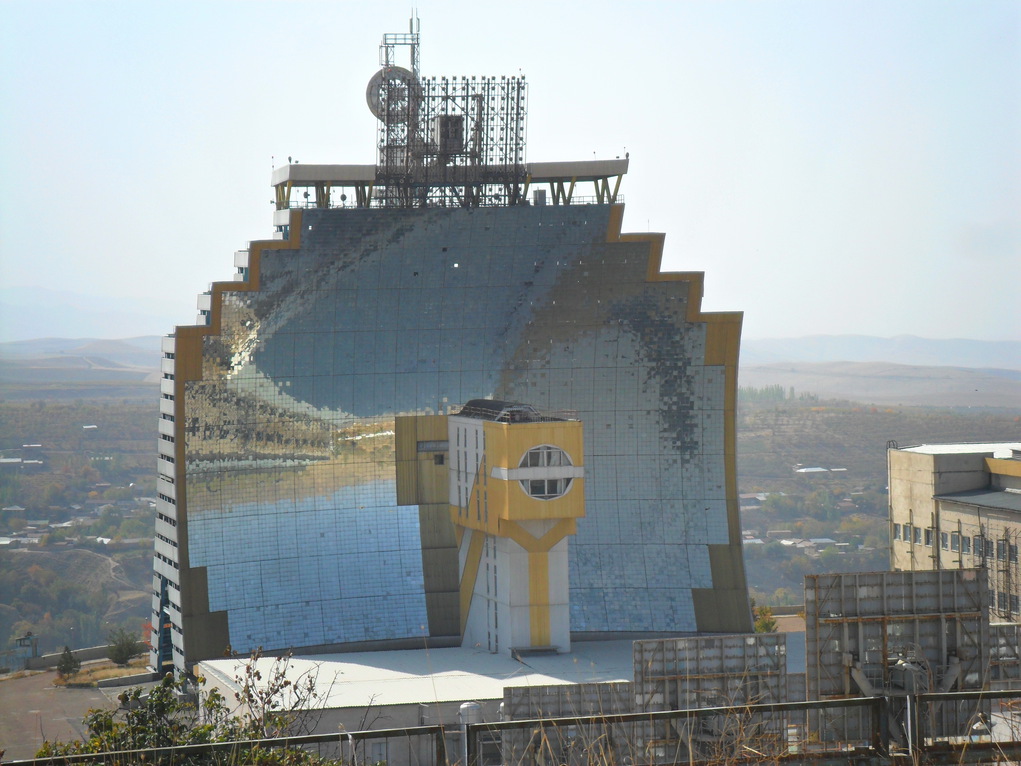|
Solar-pumped Laser
A solar-pumped laser (or solar-powered laser) is a laser that shares the same optics, optical properties as conventional lasers such as emitting a Light beam, beam consisting of Coherence (physics), coherent Electromagnetic radiation, electromagnetic radiation which can reach high power (physics), power, but which uses solar radiation for laser pumping, pumping the Active laser medium, lasing medium. This type of laser is unique from other types in that it does not require any artificial energy source. There is even a Hypothetical technology, hypothetical megastructure called a stellaser which uses a star as both the power source ''and'' the lasing medium. Lasing media The two most studied lasing media for solar-pumped lasers have been iodine,De Young et al. Preliminary Design and Cost of a 1-Megawatt Solar-Pumped Iodide Laser Space-to-Space Transmission Station, NASA Technical Memorandum, 1987Original version [...More Info...] [...Related Items...] OR: [Wikipedia] [Google] [Baidu] |
Laser
A laser is a device that emits light through a process of optical amplification based on the stimulated emission of electromagnetic radiation. The word "laser" is an acronym for "light amplification by stimulated emission of radiation". The first laser was built in 1960 by Theodore H. Maiman at Hughes Research Laboratories, based on theoretical work by Charles Hard Townes and Arthur Leonard Schawlow. A laser differs from other sources of light in that it emits light which is ''coherent''. Spatial coherence allows a laser to be focused to a tight spot, enabling applications such as laser cutting and lithography. Spatial coherence also allows a laser beam to stay narrow over great distances (collimation), enabling applications such as laser pointers and lidar (light detection and ranging). Lasers can also have high temporal coherence, which allows them to emit light with a very narrow spectrum. Alternatively, temporal coherence can be used to produce ultrashort pulses of ligh ... [...More Info...] [...Related Items...] OR: [Wikipedia] [Google] [Baidu] |
American Institute Of Physics
The American Institute of Physics (AIP) promotes science and the profession of physics, publishes physics journals, and produces publications for scientific and engineering societies. The AIP is made up of various member societies. Its corporate headquarters are at the American Center for Physics in College Park, Maryland, but the institute also has offices in Melville, New York, and Beijing. Historical overview The AIP was founded in 1931 as a response to lack of funding for the sciences during the Great Depression. /www.aip.org/aip/history "History of AIP" American Institute of Physics. July 2010. It formally incorporated in 1932 consisting of five original "member societies", and a total of four thousand members. A new set of member societies was added beginning in the mid-1960s. As soon as the AIP was established it began publishing scientific journals. [...More Info...] [...Related Items...] OR: [Wikipedia] [Google] [Baidu] |
Directed-energy Weapons
A directed-energy weapon (DEW) is a ranged weapon that damages its target with highly focused energy without a solid projectile, including lasers, microwaves, particle beams, and sound beams. Potential applications of this technology include weapons that target personnel, missiles, vehicles, and optical devices."Daily Telegraph, 12th September 2013" ''Golden Eye-style energy beam is developed by Nato scientists'', Oct. 08, 2013"Milsat Magazine, Satnews Daily, June 24th 2009" ''U.S. Navy Laser Versus UAVs... Laser Wins...'', Oct. 08, 2013 In the ... [...More Info...] [...Related Items...] OR: [Wikipedia] [Google] [Baidu] |
Applied Physics Letters
''Applied Physics Letters'' is a weekly peer-reviewed scientific journal that is published by the American Institute of Physics. Its focus is rapid publication and dissemination of new experimental and theoretical papers regarding applications of physics in all disciplines of science, engineering, and modern technology. Additionally, there is an emphasis on fundamental and new developments which lay the groundwork for fields that are rapidly evolving.Home page Applied Physics Letters. American Institute of Physics. 2016.Overview Applied Physics Letters. American Institute of Physics. 2016. The journal was established in 1962. The |
MIT Technology Review
''MIT Technology Review'' is a bimonthly magazine wholly owned by the Massachusetts Institute of Technology, and editorially independent of the university. It was founded in 1899 as ''The Technology Review'', and was re-launched without "The" in its name on April 23, 1998 under then publisher R. Bruce Journey. In September 2005, it was changed, under its then editor-in-chief and publisher, Jason Pontin, to a form resembling the historical magazine. Before the 1998 re-launch, the editor stated that "nothing will be left of the old magazine except the name." It was therefore necessary to distinguish between the modern and the historical ''Technology Review''. The historical magazine had been published by the MIT Alumni Association, was more closely aligned with the interests of MIT alumni, and had a more intellectual tone and much smaller public circulation. The magazine, billed from 1998 to 2005 as "MIT's Magazine of Innovation," and from 2005 onwards as simply "published by MIT", ... [...More Info...] [...Related Items...] OR: [Wikipedia] [Google] [Baidu] |
Magnesium Injection Cycle
The magnesium injection cycle (MAGIC) is an engine design under development by Mitsubishi Corporation and the Tokyo Institute of Technology that uses magnesium and water to generate power."-Free Engine Powers Up" Mitsubishi website"Clean Magnesium Energy Cycle Hints at Fossil Fuel Freedom" by Steve Levenstein, July 27, 2007, InventorSpot.com"TIT & Mitsubishi Prototypes Pollution-free Engine Exclu ... [...More Info...] [...Related Items...] OR: [Wikipedia] [Google] [Baidu] |
Watt
The watt (symbol: W) is the unit of power or radiant flux in the International System of Units (SI), equal to 1 joule per second or 1 kg⋅m2⋅s−3. It is used to quantify the rate of energy transfer. The watt is named after James Watt (1736–1819), an 18th-century Scottish inventor, mechanical engineer, and chemist who improved the Newcomen engine with his own steam engine in 1776. Watt's invention was fundamental for the Industrial Revolution. Overview When an object's velocity is held constant at one metre per second against a constant opposing force of one newton, the rate at which work is done is one watt. : \mathrm In terms of electromagnetism, one watt is the rate at which electrical work is performed when a current of one ampere (A) flows across an electrical potential difference of one volt (V), meaning the watt is equivalent to the volt-ampere (the latter unit, however, is used for a different quantity from the real power of an electrical circuit). : ... [...More Info...] [...Related Items...] OR: [Wikipedia] [Google] [Baidu] |
Solar Furnace Of Uzbekistan
The solar furnace of Uzbekistan was built in 1981, and is located 45 kilometers away from Tashkent city. The furnace is the largest in Asia. It uses a curved mirror, or an array of mirrors, acting as a parabolic reflector, which can reach temperatures of up to 3,000 degrees Celsius. The solar furnace of Uzbekistan can be visited by anyone who is interested in solar energy and wants to see its distinctive construction. About The heat which is produced by the solar furnace is considered to be very clean, without any pollutants. There are different ways of using this energy, such as hydrogen fuel production, foundry applications and high temperature testing. The solar furnace of Uzbekistan is sometimes called the Sun Institute of Uzbekistan. The furnace is a complex optical and mechanical construction, with 63 flat mirrors automatically controlled to track the sun in unison and redirect the solar thermal energy towards the crucible. The furnace was first opened in May 1981, and i ... [...More Info...] [...Related Items...] OR: [Wikipedia] [Google] [Baidu] |
Space-based Solar Power
Space-based solar power (SBSP, SSP) is the concept of collecting solar power in outer space by solar power satellites (SPS) and distributing it to Earth. Its advantages include a higher collection of energy due to the lack of reflection and absorption by the atmosphere, the possibility of no (or very little) night, and a better ability to orient to face the sun. Space-based solar power systems convert sunlight to some other form of energy (such as microwaves) which can be transmitted through the atmosphere to receivers on the Earth's surface. It is attractive to those seeking large-scale solutions to anthropogenic climate change or fossil fuel depletion (such as peak oil). Various SBSP proposals have been researched since the early 1970s, but none is economically viable with present-day space launch costs. Some technologists speculate that this may change in the distant future with space manufacturing from asteroids or lunar material, or with radical new space launch techno ... [...More Info...] [...Related Items...] OR: [Wikipedia] [Google] [Baidu] |
Beam-powered Propulsion
Beam-powered propulsion, also known as directed energy propulsion, is a class of aircraft or spacecraft propulsion that uses energy beamed to the spacecraft from a remote power plant to provide energy. The beam is typically either a microwave or a laser beam and it is either pulsed or continuous. A continuous beam lends itself to thermal rockets, photonic thrusters and light sails, whereas a pulsed beam lends itself to ablative thrusters and pulse detonation engines. The rule of thumb that is usually quoted is that it takes a megawatt of power beamed to a vehicle per kg of payload while it is being accelerated to permit it to reach low earth orbit. Other than launching to orbit, applications for moving around the world quickly have also been proposed. Background Rockets are momentum machines; they use mass ejected from the rocket to provide momentum to the rocket. Momentum is the product of mass and velocity, so rockets generally attempt to put as much velocity into their worki ... [...More Info...] [...Related Items...] OR: [Wikipedia] [Google] [Baidu] |
Free-space Optical Communication
Free-space optical communication (FSO) is an optical communication technology that uses light propagating in free space to wirelessly transmit data for telecommunications or computer networking. "Free space" means air, outer space, vacuum, or something similar. This contrasts with using solids such as optical fiber cable. The technology is useful where the physical connections are impractical due to high costs or other considerations. History Optical communications, in various forms, have been used for thousands of years. The ancient Greeks used a coded alphabetic system of signalling with torches developed by Cleoxenus, Democleitus and Polybius. In the modern era, semaphores and wireless solar telegraphs called heliographs were developed, using coded signals to communicate with their recipients. In 1880, Alexander Graham Bell and his assistant Charles Sumner Tainter created the photophone, at Bell's newly established Volta Laboratory in Washington, DC. Bell considered it ... [...More Info...] [...Related Items...] OR: [Wikipedia] [Google] [Baidu] |
Photovoltaic
Photovoltaics (PV) is the conversion of light into electricity using semiconducting materials that exhibit the photovoltaic effect, a phenomenon studied in physics, photochemistry, and electrochemistry. The photovoltaic effect is commercially used for electricity generation and as photosensors. A photovoltaic system employs solar modules, each comprising a number of solar cells, which generate electrical power. PV installations may be ground-mounted, rooftop-mounted, wall-mounted or floating. The mount may be fixed or use a solar tracker to follow the sun across the sky. Photovoltaic technology helps to mitigate climate change because it emits much less carbon dioxide than fossil fuels. Solar PV has specific advantages as an energy source: once installed, its operation generates no pollution and no greenhouse gas emissions, it shows scalability in respect of power needs and silicon has large availability in the Earth's crust, although other materials required in PV system man ... [...More Info...] [...Related Items...] OR: [Wikipedia] [Google] [Baidu] |




